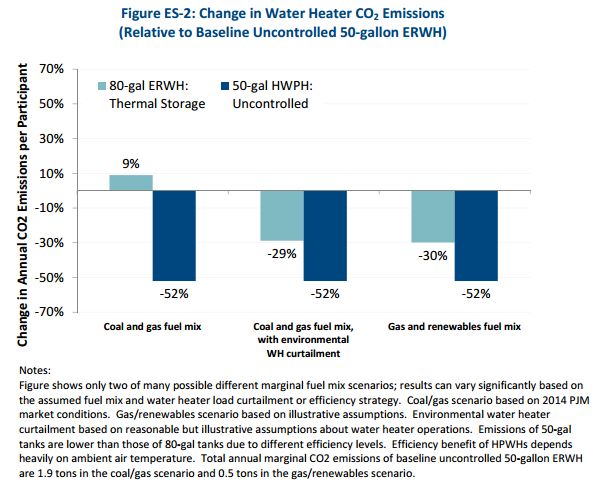This report was prepared for the National Rural Electric Cooperative Association (NRECA), the Natural Resources Defense Council (NRDC), and the Peak Load Management Alliance (PLMA).
Executive Summary
While conventional water heating load control and energy efficiency programs have been offered in the U.S. for decades, new developments have led to the rediscovery of water heaters as an attractive opportunity for improving the reliability, economics, and environmental footprint of the power grid. In particular, the growing adoption of intermittent sources of generation, such as wind and solar, is leading utilities, power system operators, and regulators to explore new ways to reliably and cost-effectively integrate renewables onto the power system. "Flexible load" in the form of demand response or behind-the-meter energy storage is frequently discussed as a possible solution.
Electric water heaters are essentially pre-installed thermal batteries that are sitting idle in more than 50 million homes across the U.S.1 By heating the water in the tank to store thermal energy, water heaters can be controlled in real-time to shift electricity consumption from higher-priced hours when less efficient generating units are operating on the margin to lower-priced hours when less costly generation is operating on the margin and, in some cases, there may be excess supply of energy from low- or zero-emitting resources such as wind power. Further, recent technological advancements have enabled "grid interactive water heaters" to be controlled over very short time intervals and with near instantaneous response, allowing them to provide frequency regulation and other grid balancing services that are highly valuable in markets with rapid fluctuations in supply.
In addition, a policy focus on clean energy is driving interest in energy efficiency improvements. A new federal energy efficiency standard for large electric water heaters, combined with subsequent legislation that allows for the manufacture of grid-enabled electric resistance water heaters, has created a significant opportunity for reductions in both cost and emissions from a large source of residential energy consumption.2
The magnitude of this relatively untapped resource is significant. Electric water heaters account for 9% of all electricity consumed by households nationally. This represents the third single largest source of residential electricity consumption, behind only space cooling (13%) and lighting (11%).3 More than 40 percent of U.S. households have electric water heating.4
In light of these opportunities, the purpose of this study is to analyze the economics of a range of advanced electric water heating load control and energy efficiency strategies that utilities and demand response aggregators could implement to reduce total system costs.
We consider two types of electric water heating technologies: electric resistance water heaters (ERWHs), which use an electric heating element to directly heat water and maintain a desired temperature by turning on and off in short "bursts" of energy; and heat pump water heaters (HPWHs) which draw heat from the surrounding air to heat the water. The heat pump water heaters typically use electricity at a low and steady state, though a "hybrid" form of HPWHs also has an electric heating element which can provide additional heating capability when needed.
We evaluate the economics of several different strategies for controlling the load of these water heaters. The strategies include conventional "peak shaving" in which load is curtailed during peak hours on a limited number of days per year, "thermal storage" in which the water is heated each night to avoid higher priced hours during the day, and a "fast response" strategy that would provide balancing services in the form of quick load increases and decreases. Drawing upon detailed simulations of water heater operations and with consideration for different market structures, we assess the economic and environmental impacts of five water heating strategies for two different water tank sizes and three distinctly different market scenarios.
Advanced electric water heating strategies, such as providing ancillary services, storing thermal energy on a daily basis, or adopting heat pumps, can provide significant value. We find that, in some cases, the net benefits of these approaches could reach around $200 per participant per year under certain market conditions. This would effectively pay for the entire cost of the water heater and associated control equipment (including installation) in 5 years. Considering only incremental costs of the advanced control capability, the payback period is around 3 years. Both HPWHs and controlled ERWHs can have very strong positive economics, depending on market conditions. Controlled ERWHs provide the largest economic benefit on a per-water heater basis under the market scenarios analyzed in this study. Figure ES-1 shows the estimated incremental annualized net benefits of each of the water heating strategies analyzed in this study, based on market prices observed in PJM in 2014.5 These net benefits are incremental relative to maintaining an uncontrolled 50-gal ERWH (the baseline assumption).

The environmental impacts of ERWHs depend heavily on the water heating control strategy being considered and the composition of the generation supply mix of the power system. Generally, HPWHs provide the most consistent environmental benefit on a per-water heater basis through overall reductions in energy consumption, reducing CO2 emissions by approximately 50% relative to an uncontrolled ERWH in our analysis.6 The environmental case for controlled ERWHs is more nuanced, but also appears to have significant potential due to a combination of strong economics and modest direct emissions impacts.
Figure ES-2 illustrates the CO2 emissions impact of two of the water heating strategies - an 80- gallon ERWH curtailed on a daily basis to provide thermal energy storage, and a 50-gallon uncontrolled HWPH. The emissions impact was estimated for two markets with a different assumed generation supply mix - one with coal and gas as the marginal supply and the second with gas renewables as the marginal supply. In the market scenario with coal and gas on the margin, we considered a case when the ERWH is curtailed purely for economic reasons (i.e., to maximize energy, capacity and ancillary services cost savings) and a case when it is curtailed to shift load away from hours with higher emissions.

The emerging load control and efficiency strategies are complementary to established options that have been in practice for decades, such as peak load shaving. The benefits of all of these strategies may be best maximized through a portfolio-based offering rather than promoting only one single technology type, particularly as the capabilities of the technology continue to evolve and the industry gains experience with these options. Specific observations about each water heating strategy include:
- The Peak Shave strategy is well suited for market conditions in which there is a peak demand-driven need for generation and/or transmission capacity, a relatively flat energy price profile, and/or a limited ability to promote adoption of larger ERWH tank sizes.
- The Thermal Storage strategy can significantly increase benefits relative to the Peak Shave strategy, at little incremental cost, if offered to customers with larger (80+ gallon) water tanks in market conditions with a significant price differential between peak and off-peak periods.
- The Fast Response strategy can significantly increase benefits over the other two load control strategies in markets with a need for resources that can quickly ramp load up and down. Ancillary services benefits are less dependent on tank size but very dependent on market conditions, including whether market rules allow demand-side resources to participate in ancillary services markets.
- Uncontrolled heat pump water heaters provide significant economic and environmental benefits in those locations where often-challenging technical factors can be effectively addressed.
While the findings in this study are robust across a diverse range of market scenarios, they certainly depend on regional market conditions. A detailed economic analysis should be conducted in any market where a new program is being considered. Moving forward, there are a variety of new initiatives that would extend the findings of this study and further enhance the industry's understanding of emerging opportunities in electric water heating. These include:
- Assess techniques for optimal management and dispatch of a portfolio of water heaters. This could include optimized dispatch of an individual water heater across the various value streams (energy, capacity, ancillary services, and environmental impacts). It could also include analysis of a "community storage" approach to water heating load control which would coordinate the dispatch across a portfolio of water heaters to maximize the value of the program to the grid. It could also include location-specific dispatch of the water heaters and other sources of load to increase distribution system benefits, an issue that is being explored currently through initiatives in New York, California, and Hawaii, among other jurisdictions.
- Analyze participant benefits. In addition to the system/societal costs and benefits analyzed in this study, analysis of the bill savings to participants and non-participants would provide insight regarding the customer-facing policies and incentive structures that could be used to facilitate economic participation in the programs.
- Analyze the impact of varying levels of adoption of the water heating strategies on wholesale electricity market prices. Particularly as it relates to ancillary services, large levels of adoption of water heaters used as storage on the electricity grid could have a significant impact on the wholesale electricity market prices, so accounting for the "depth" of the market would be an informative extension of this study.
- Extend the analysis to other market settings. This analysis focused on benefits in the PJM and MISO markets. Expanding to additional markets with different market rules, such as ERCOT, CAISO, or international markets, for example, would provide further insight as to the performance of the strategies across a range of market conditions.
To continue reading this article, please click here
The authors would like to thank Keith Dennis of NRECA, Robin Roy of NRDC, Gary Connett of Great River Energy, and Steven Koep of Vaughn Thermal Corporation. Their insights, leadership, experience, and data were invaluable to this project. Dr. Carl Hiller of Applied Energy Technologies developed the water heater simulations upon which many of the assumptions in this study are based. We would also like to thank our Brattle colleague Cady Wiltsie for her excellent modeling and research support.
Footnotes
1 See U.S. Census Bureau (2013).
2 In 2010, the U.S. Department of Energy (DOE) established an energy efficiency standard that would effectively require all new residential electric water heaters above 55 gallons to be heat pump water heaters, beginning April 2015. Congress subsequently passed the Energy Efficiency Improvement Act of 2015, which includes an exception to this rule for high-efficiency 75+ gallon electric resistance water heaters that are "grid-enabled" and intended for participation in a demand response program.
3 See EIA (2015).
4 See U.S. Census Bureau (2013).
5 The figure shows benefits associated with a single incremental water heater. The analysis does not account for the dynamic impact that participation in large quantities may have on market prices; this is an important area for further research.
6 Note that the efficiency gains of HPWHs are heavily dependent on the temperature of the surrounding air, making them better suited for warmer rather than colder environments. Therefore, the potential benefits of HPWHs can vary significantly across regions and climates.
The content of this article is intended to provide a general guide to the subject matter. Specialist advice should be sought about your specific circumstances.


